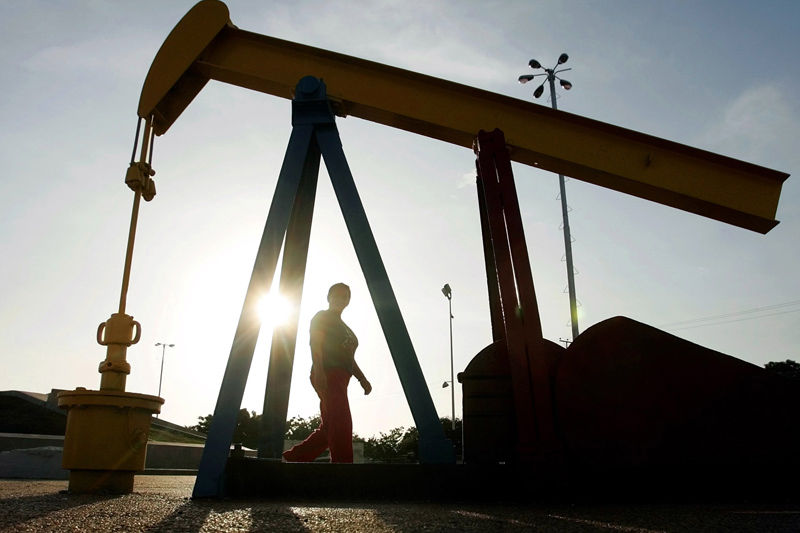Investing.com - Crude oil futures were higher during European morning hours on Tuesday, as hopes for further easing measures by global central banks and escalating tensions between Iran and the West supported prices.
Gains were limited amid concerns over the global economic outlook and its implications on demand prospects.
On the New York Mercantile Exchange, light sweet crude futures for delivery in August traded at USD84.25 a barrel during European morning trade, adding 0.6%.
It earlier rose by as much as 1.1% to trade at a session high of USD84.62 a barrel.
The U.S. Institute for Supply Management said Monday that its index of purchasing managers fell by 3.8 point to 49.7 in June from a reading of 53.5 in May, the first contraction since July 2009.
The data fuelled speculation that the Federal Reserve may implement a third round of quantitative easing, to shore up growth in the U.S. economy, which has been hit by the ongoing crisis in the euro zone.
In the euro zone, the final reading of the bloc’s manufacturing index came in at 45.1 in June, holding steady at its lowest level since June 2009.
Investors were looking ahead to the outcome of the European Central Bank’s monetary policy meeting on Thursday, amid growing expectations for a rate cut.
Meanwhile, in China, a government report showed that Chinese manufacturing activity grew at its slowest pace in seven months in June, as new export orders tumbled to lows hit in March 2009.
The China Securities Journal, a state-run newspaper, said the time is ripe for China to cut banks’ reserve requirements as slowing inflation gives more room for easing to stabilize growth.
China is the world's second largest oil consumer after the U.S. and has been the engine of strengthening demand.
Oil prices found further support after media outlets in Tehran reported that Iran's National Security and Foreign Policy Committee drafted a bill proposing to block the Strait of Hormuz for oil tankers in response to a European Union oil embargo on imports from Iran, which started on July 1.
The Strait of Hormuz, located between Iran and Oman, is one of the most important oil-shipping channels in the world, handling about 33% of all ocean-borne traded oil, according to the U.S. Energy Information Administration.
Elsewhere, on the ICE Futures Exchange, Brent oil futures for August delivery added 0.45% to trade at 97.78 a barrel, with the spread between the Brent and crude contracts standing at USD13.53.
Brent prices have been well-supported in recent sessions amid concerns over a disruption to supplies from Norway, the world's eighth largest oil exporter.
Gains were limited amid concerns over the global economic outlook and its implications on demand prospects.
On the New York Mercantile Exchange, light sweet crude futures for delivery in August traded at USD84.25 a barrel during European morning trade, adding 0.6%.
It earlier rose by as much as 1.1% to trade at a session high of USD84.62 a barrel.
The U.S. Institute for Supply Management said Monday that its index of purchasing managers fell by 3.8 point to 49.7 in June from a reading of 53.5 in May, the first contraction since July 2009.
The data fuelled speculation that the Federal Reserve may implement a third round of quantitative easing, to shore up growth in the U.S. economy, which has been hit by the ongoing crisis in the euro zone.
In the euro zone, the final reading of the bloc’s manufacturing index came in at 45.1 in June, holding steady at its lowest level since June 2009.
Investors were looking ahead to the outcome of the European Central Bank’s monetary policy meeting on Thursday, amid growing expectations for a rate cut.
Meanwhile, in China, a government report showed that Chinese manufacturing activity grew at its slowest pace in seven months in June, as new export orders tumbled to lows hit in March 2009.
The China Securities Journal, a state-run newspaper, said the time is ripe for China to cut banks’ reserve requirements as slowing inflation gives more room for easing to stabilize growth.
China is the world's second largest oil consumer after the U.S. and has been the engine of strengthening demand.
Oil prices found further support after media outlets in Tehran reported that Iran's National Security and Foreign Policy Committee drafted a bill proposing to block the Strait of Hormuz for oil tankers in response to a European Union oil embargo on imports from Iran, which started on July 1.
The Strait of Hormuz, located between Iran and Oman, is one of the most important oil-shipping channels in the world, handling about 33% of all ocean-borne traded oil, according to the U.S. Energy Information Administration.
Elsewhere, on the ICE Futures Exchange, Brent oil futures for August delivery added 0.45% to trade at 97.78 a barrel, with the spread between the Brent and crude contracts standing at USD13.53.
Brent prices have been well-supported in recent sessions amid concerns over a disruption to supplies from Norway, the world's eighth largest oil exporter.
